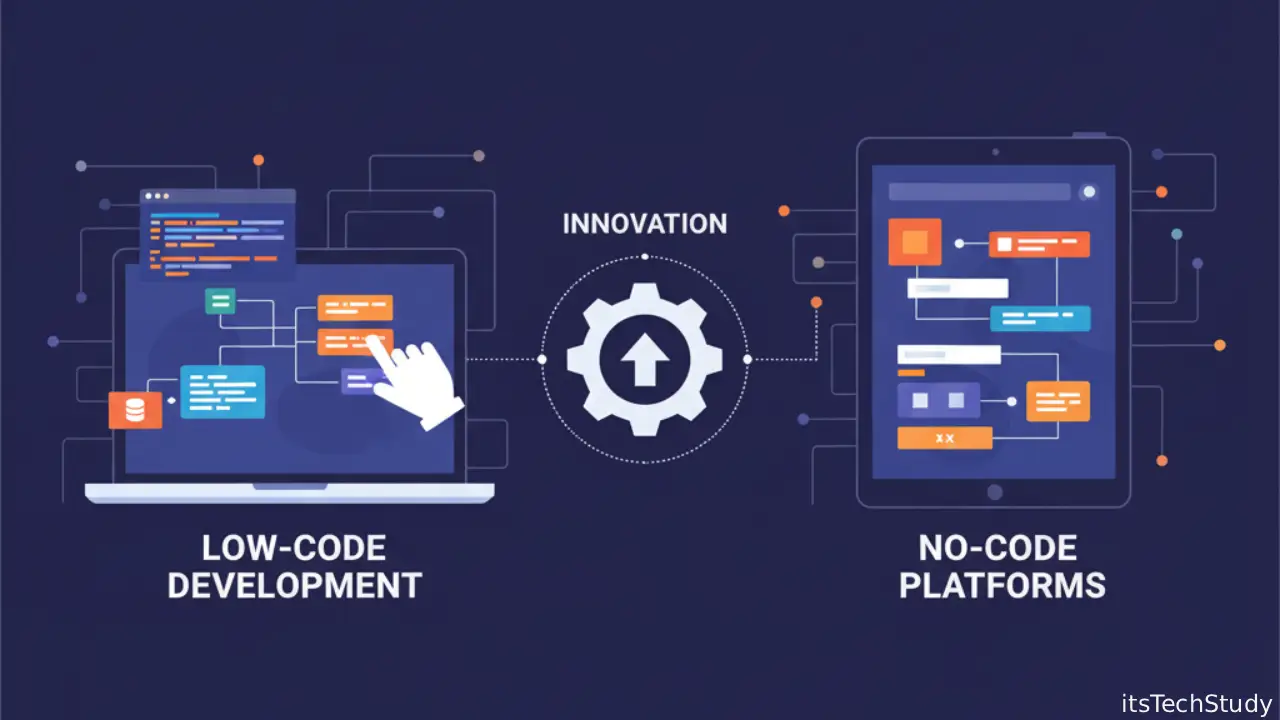Introduction: The Shift in How Software Gets Built
A decade ago, building software was a task limited to skilled programmers who spent countless hours writing and debugging complex lines of code. Businesses had to hire large development teams, invest in expensive infrastructure, and wait months (sometimes years) before launching a simple application.
But times have changed. The modern digital landscape demands speed, agility, and cost-efficiency. Every business-from startups to enterprises-needs to innovate faster. This demand led to the rise of Low-Code and No-Code Development Platforms, a revolutionary approach that allows both developers and non-developers to create applications visually, without traditional coding.
Today, platforms like Microsoft Power Apps, OutSystems, AppSheet, and Bubble are transforming how apps are built. They’re bridging the gap between technical and non-technical users, empowering organizations to innovate at record speed.
So, what exactly are low-code and no-code platforms, how do they differ, and why are they reshaping the software industry? Let’s explore.
Understanding Low-Code and No-Code Development
What Is a Low-Code Platform?
A Low-Code Platform provides a visual interface for application development but still allows developers to add custom code when necessary. It’s ideal for professional developers who want to accelerate their workflow without compromising flexibility.
Typical features include:
- Drag-and-drop builders
- Pre-built modules and templates
- Integration capabilities with APIs and external systems
- Optional coding for advanced customization
Examples: OutSystems, Mendix, Microsoft Power Apps
What Is a No-Code Platform?
A No-Code Platform, on the other hand, enables non-developers-often called citizen developers-to create applications using visual tools, logic flows, and ready-to-use components. No prior programming knowledge is required.
Examples: Bubble, Glide, Airtable, AppSheet
Key Differences Between Low-Code and No-Code Platforms
| Aspect | Low-Code Platform | No-Code Platform |
|---|---|---|
| Target Users | Developers & IT professionals | Non-developers, business users |
| Customization | Allows custom coding | No coding allowed |
| Complexity | Handles complex apps | Best for simple to moderate apps |
| Flexibility | High | Limited |
| Use Cases | Enterprise systems, integrations | Internal tools, MVPs, small apps |
Why Low-Code and No-Code Are the Future of Software Development
1. Speed and Efficiency
Traditional app development can take months or even years. With low-code and no-code platforms, teams can prototype, test, and launch apps in a matter of days or weeks.
2. Reduced Costs
Hiring professional developers is expensive. These platforms minimize the need for large technical teams, cutting development and maintenance costs significantly.
3. Democratization of Technology
Now, anyone with a business idea can bring it to life. From marketing managers to HR executives, employees can create tools that solve real problems without waiting for IT departments.
4. Agility in Digital Transformation
Businesses can respond faster to market changes, customer demands, and new opportunities through agile app development cycles.
5. Seamless Integration
Modern low-code tools support integration with major platforms like Salesforce, Google Workspace, and Microsoft 365, ensuring smooth data flow and automation.
How Low-Code and No-Code Platforms Work
1. Visual Interface
Users design the app through drag-and-drop builders, choosing components like buttons, forms, and charts.
2. Workflow Automation
These platforms allow you to create logic flows—automated rules that define what happens when a user interacts with the app.
3. Database Connection
Apps can connect to internal or external data sources such as Excel, SQL, or APIs for dynamic content.
4. Deployment
Once the app is ready, it can be instantly deployed to the web or mobile devices—no compiling, hosting, or deployment hassles.
Popular Low-Code and No-Code Platforms in 2025
| Platform | Type | Best For | Key Features |
|---|---|---|---|
| OutSystems | Low-Code | Enterprises | Advanced integration, scalability, and security |
| Mendix | Low-Code | Businesses of all sizes | Collaborative tools, cloud support |
| Microsoft Power Apps | Low-Code | Microsoft ecosystem users | Seamless Office 365 integration |
| AppSheet (by Google) | No-Code | SMBs, data-driven apps | Spreadsheet-based development |
| Bubble | No-Code | Startups & entrepreneurs | Visual app builder, workflows, plugins |
| Glide | No-Code | Mobile-first apps | Google Sheets integration, templates |
Pros and Cons of Low-Code and No-Code Development
Pros
- Rapid Development – Build and launch apps in record time
- Cost-Effective – Reduce hiring and infrastructure costs
- Accessible – Empowers non-technical users
- Easy Maintenance – Automatic updates and scalability
- Cross-Platform Support – Build once, deploy anywhere
Cons
- Limited Customization (especially in no-code)
- Vendor Lock-In – Dependency on specific platforms
- Performance Constraints for large-scale apps
- Learning Curve for complex workflows
- Integration Limitations with legacy systems
Use Cases of Low-Code and No-Code Platforms
- Internal Business Tools – Automating workflows, approvals, and dashboards.
- Customer Portals – Simplified interfaces for client interaction.
- MVP Development – Quickly validating startup ideas.
- Data Management Apps – Organizing and visualizing business data.
- E-commerce Solutions – Building functional online stores fast.
How Businesses Benefit from Adopting These Platforms
- Faster Time-to-Market: Quickly adapt to changing market demands.
- Empowered Workforce: Business users can build their own tools.
- Innovation Culture: Encourages experimentation and creativity.
- Scalability: Many platforms support enterprise-grade expansion.
Tips for Getting Started with Low-Code and No-Code Platforms
- Identify Your Use Case – Start with a clear business problem to solve.
- Choose the Right Platform – Match features to your team’s skills and project scale.
- Start Small – Build simple internal apps before moving to complex systems.
- Ensure Data Security – Follow governance and compliance standards.
- Collaborate Across Teams – Involve both IT and business departments for best outcomes.
Future Trends in Low-Code and No-Code Development
- AI-Driven App Builders: Integrating artificial intelligence to auto-generate workflows and UI components.
- Hyperautomation: Combining no-code tools with AI, ML, and RPA for total process automation.
- Cross-Platform Flexibility: Build once, deploy across web, mobile, and wearable devices.
- Increased Enterprise Adoption: Large organizations adopting low-code for mission-critical systems.
- Integration with Cloud & IoT: Seamless data connectivity across devices and ecosystems.
Conclusion: Building the Future-One Click at a Time
Low-code and no-code platforms are redefining how we think about software development. They’ve turned what once required deep technical knowledge into something accessible, efficient, and empowering.
From startups building their first MVPs to enterprises modernizing legacy systems, these platforms are fueling a new wave of digital innovation.
In a world where agility equals success, mastering low-code and no-code tools isn’t just an advantage-it’s essential. The future of app development is not about who can code the most, but who can innovate the fastest.
FAQs About Low-Code and No-Code Development
Q1: Can I build complex applications using a no-code platform?
Ans: No-code platforms are best for simple to moderately complex apps. For highly customized or enterprise-grade apps, a low-code platform is more suitable.
Q2: Are these platforms secure enough for business use?
Ans: Yes, most reputable platforms offer enterprise-grade security, role-based access, and compliance with standards like GDPR and ISO.
Q3: How much do low-code or no-code platforms cost?
Ans: Pricing varies. Some tools offer free tiers (like AppSheet or Glide), while enterprise solutions like OutSystems or Mendix require licensing fees.
Q4: Can low-code tools replace traditional developers?
Ans: Not entirely. They complement developers by speeding up repetitive or UI-focused tasks, but complex systems still need professional coding.
Q5: What skills do I need to use these platforms?
Ans: Basic understanding of logic, workflows, and business processes. No advanced programming knowledge is required.
Q6: How do I choose between low-code and no-code?
Ans: Choose no-code if you’re a non-technical user building simple tools. Opt for low-code if you’re a developer or team needing flexibility and scalability.












No Comments Yet
Be the first to share your thoughts.
Leave a Comment